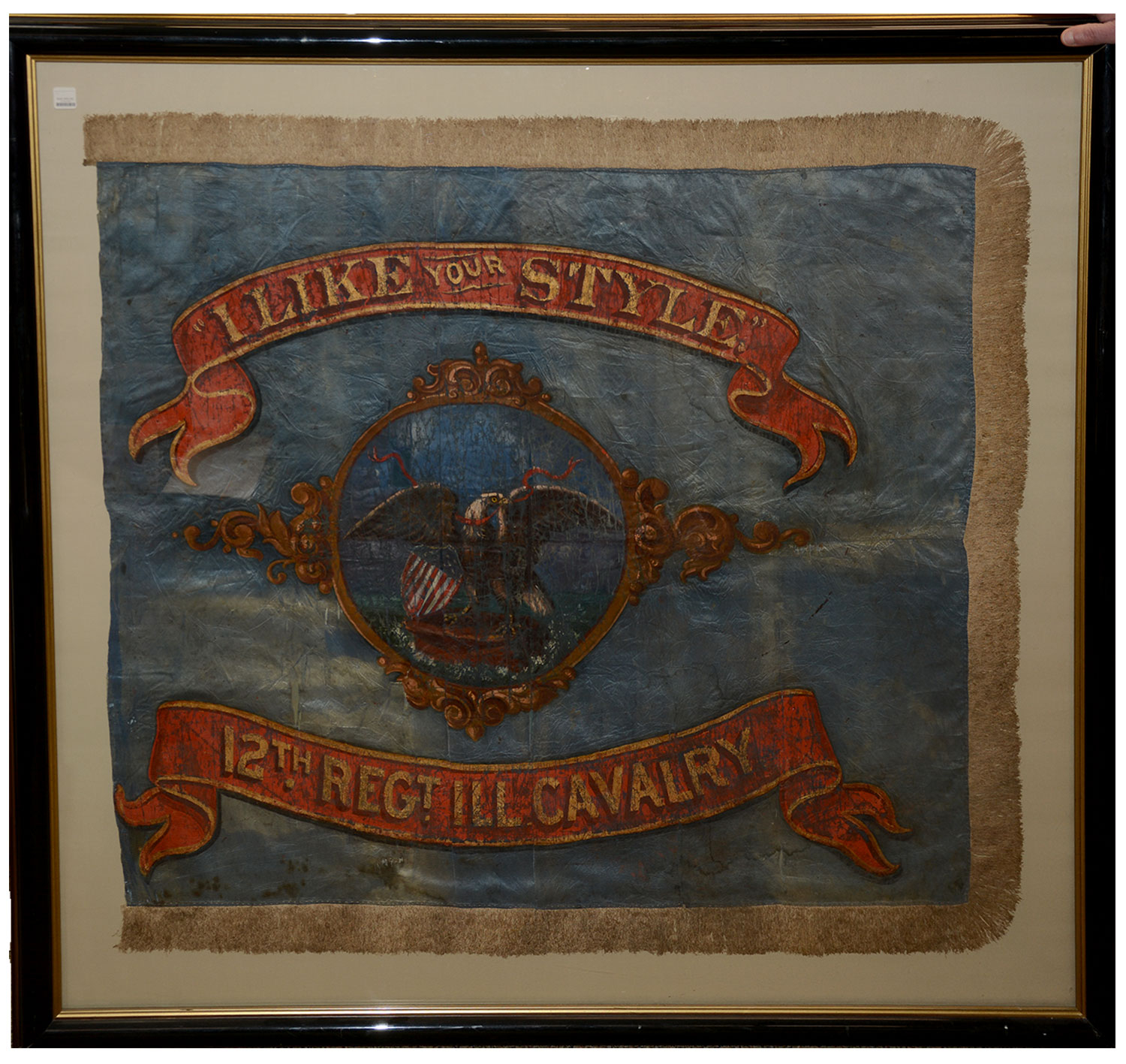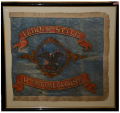site search
online catalog
“I LIKE YOUR STYLE” THE REGIMENTAL STANDARD OF THE 12th ILLINOIS CAVALRY: GAMBLE’S BRIGADE UNDER BUFORD ON JULY 1 AT GETTYSBURG

$45,000.00
Quantity Available: 1
Item Code: 1179-033
Shipping: Determined by Method & Location of buyer
To Order:
Call 717-334-0347,
Fax 717-334-5016, or E-mail
We can’t think of a more flamboyant, devil-may-care motto on a cavalry standard than this one, whose overtly casual nature no doubt intentionally contrasts with their combat and fighting record. Placed in quotation marks, this was taken from the greeting given them by the Governor of Illinois when they returned to the state on veteran furlough in late 1863, after seeing heavy action in Virginia, and before their return to the front for further action in the deep south in Louisiana, Mississippi, and elsewhere. This striking flag comes with a letter of authenticity from respected vexillologist Howard Madaus and a conservation treatment report by Jessica Hack Textile Restoration of New Orleans made when the flag was in the hands of dealer Gary Hendershott in 1998-1999. Most recently it was in the collections of the Texas Civil War Museum, something fully appropriate since the regiment not only had active service in the eastern theatre, including Gettysburg, up to late 1863, its western theatre service included duty in Texas from 1865 to its muster out in 1866.
The flag is mentioned by a veteran in an 1893 regimental reunion pamphlet, though at that point in time, its location was unknown, at least to that veteran, and he misremembered the emblem on the flag as a rampant horse rather than a U.S. eagle, but clearly remembered the motto emblazoned on the flag and its origin. Blackwell’s 2002 regimental history pictures it, cites the 1893 reference to it, recounts its origin, and mentions it was recently in the hands of a dealer. Schmale’s 2024 book on Civil War flags of Illinois quotes that 1893 reference also, but does not picture it and is unaware of its whereabouts at that point. Blackwell, however, also filled in some background, stating that the Governor’s speech was given at the Armory in Chicago to the freshly arrived veterans with “I like your style!” concluding a recitation of their engagements and deeds in the war so far. He also goes on to state the flag was made by a group of citizens during the regiment’s furlough and was presented to them before they left again for the front, which is unsourced though likely correct, even if he means it was commissioned by a group of citizens rather than actually made by them.
The flag itself is made of a single layer of blue silk and measures 35-1/2” on the hoist by 39” on the fly, with an additional 2-1/2 gold, now somewhat beige, silk fringe on three sides. (Madaus and Hack agree closely in dimensions, though Hack seems to have included the fringe twice.) Both sides were painted win a central panel roughly 13” by 13-1/2” edged in a gold rococo frame with wide floral scroll flourishes to the left and right and shallower ones at top and bottom. This is framed top and bottom by black and gold-bordered red, forked-tail ribbon scrolls in arcs, the top one reading “I LIKE YOUR STYLE” in gold uncial letters with “your” in smaller block letters, emphasized also by and upward arc and lines above and below it, and with quotation marks included around the phrase. The lower scroll is painted in gold block letters, “12th REGT. ILL CAVALRY.”
The cartouche on both sides is painted with the arms of the U.S. – an American eagle with raised wings, E Pluribus Unum ribbon, arrows and olive branch. On the reverse, the eagle has a US shield on its chest, is set against a red and gold sunburst glory. On the obverse, showing as framed, the eagle is perched on reddish rock against which crash stormy waves of the sea, a pretty clear allusion to the war, and stretches its wings straight out to either side, likely a defiant, protective pose, with the U.S. shield resting tilted at angle at its lower right side, the viewer’s left.
A two-page conservation treatment report with photos accompanies the flag. The flag was conserved and stabilized with the application of matching silk and crepeline silk fabrics on the reverse to close up tears, etc. The obverse painting was then infilled or restored where worn away, including some of the lettering, a 1-1/2” by 4” section of the rock, and 1” by 2” hole in the sky over one of the eagle’s wings, including a portion of the red ribbon, and some paint along a vertical slit. As conserved and framed, the flag measures 000 by 000 overall.
Schmale’s 2024 book on flags indicates only two other flags are known from the regiment: one, a more conventional regimental standard turned into the state and the other an unmarked company guidon, though Blackwell says there were “a couple” turned in by Companies E and F and pictures them, along with this flag. As a privately presented flag given to the regiment or its commander, this one, of course, was not state property and not turned in.
The regiment has an impressive combat record well meriting the Governor’s praise. We show Dyer’s detailed summary of their assignments and service in the listing. Among its earliest actions were encounters with the enemy at Martinsburg and Darkesville in September 1862 where some sixty troopers under Colonel Davis routed a considerably larger force of Confederate cavalry in an impromptu charge made necessary when they came upon one another at close quarters. Both sides overestimated the number of the enemy they faced and the casualties they inflicted, but the victory seems clearly to have belonged to the Illinois troopers. Less than two weeks later they improved upon their record by participating in the cavalry breakout from besieged Harpers Ferry on the night of September 14, 1862, not only getting through enemy lines and reaching Federal lines, but bagging a considerable Confederate wagon train in the process.
During the Chancellorsville campaign in 1863, they took part in Stoneman’s raid deep behind Confederate lines in an effort to divert attention from Hooker’s advance to Chancellorsville and sever lines of communication and supply, destroying railroad and telegraph lines, destroying wagons, capturing mules, etc., during an arduous journey, finally reaching Gloucester Point, near Yorktown. Part of the regiment remained there and at Fortress Monroe, while four companies were sent to Alexandria and rejoined the Army of the Potomac in time for Gettysburg where they fought on July 1 in Buford’s critical stand west of the town, buying time for Union infantry to come up, losing 20 men out of 233 on the field in the day’s fighting, and later saw action at Williamsport, Beaver Creek, Falling Waters, etc.
After reenlisting as a veteran regiment they were sent back to Illinois to recruit, reaching Chicago in late November, and then departing for St. Louis and New Orleans in February 1864, where they served under Banks and fought guerrillas in the bayou area from Alexandria to Morganza, followed by picket duty, scouting, and a raid in November a raid against the Mobile and Ohio RR in eastern Tennessee, then a move to Vicksburg, Memphis, and into Arkansas in early 1865 taking part in an expedition through southern Arkansas and northern Louisiana in early March, and then into northern Mississippi. At the end of the fighting, they were ordered to Alexandria, Louisiana, and in August to Texas, where they mustered out at Houston on May 29, 1866, having lost 38 enlisted men killed and mortally wounded, and 4 Officers and 192 enlisted men by disease, with, of course, scores of others wounded or disabled from their service.
This is a remarkable, dashing flag, from a very active cavalry regiment. [sr] [PH:L]
EXTRA SHIPPING REQUIRED.
~~~~~~~~~~~~~~~~~~~~~~~~~~~~~~~~~~~
THIS ITEM, AS WITH ALL OTHER ITEMS AVAILABLE ON OUR WEB SITE,
MAY BE PURCHASED THROUGH OUR LAYAWAY PROGRAM.
CLICK HERE FOR OUR POLICIES AND TERMS.
THANK YOU!
Inquire About “I LIKE YOUR STYLE” THE REGIMENTAL STANDARD OF THE 12th ILLINOIS CAVALRY: GAMBLE’S BRIGADE UNDER BUFORD ON JULY 1 AT GETTYSBURG
For inquiries, please email us at [email protected]
Most Popular
Historical Firearms Stolen From The National Civil War Museum In Harrisburg, Pa »
Theft From Gravesite Of Gen. John Reynolds »
Selection Of Unframed Prints By Don Troiani »
Fine Condition Brass Infantry Bugle Insignia »
British Imported, Confederate Used Bayonet »
Scarce New Model 1865 Sharps Still In Percussion Near Factory New »
featured item
CONFEDERATE FIRST NATIONAL FLAG FROM ISLAND NUMBER TEN
This Confederate First National flag has a tight provenance going back to 1935, and before that an oral history as a war souvenir brought back from Island Number Ten by James William McLaughlin, a prominent Cincinnati architect who in 1861 had served… (1179-004). Learn More »
site search
Upcoming Events
May 16 - 18: N-SSA Spring Nationals, Fort Shenandoah, Winchester, VA Learn More »






